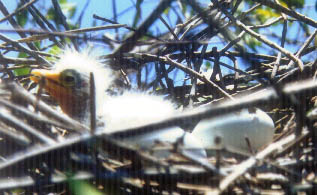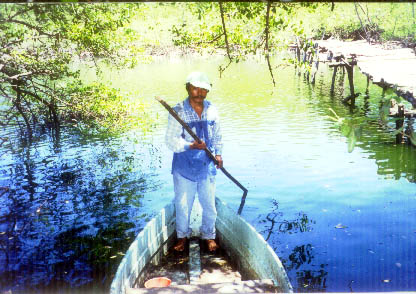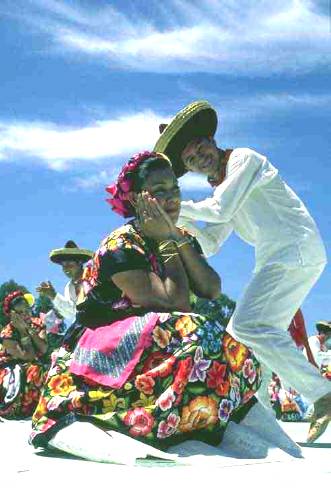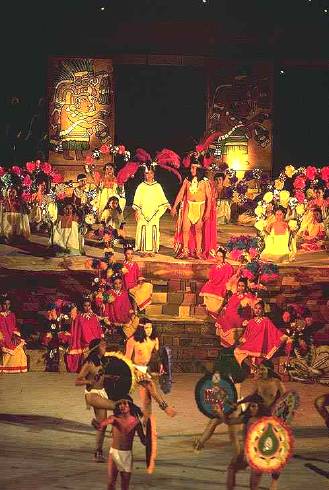

Fri 5
School's Out
Schools close for summer vacation throughout México. Good news for local merchants because it hopefully portends the arrival of lots of visitors to revive the local economy that has been languishing through the traditionally slow month of June.
Wed 10
New Moon in Cancer at 5:26 a.m.
Fri 12
Lawyer's Day
All trades and professions in México have a day on which their contribution to society is recognized. Yes, even lawyers.
Mon 15
Secretary's Day
See above.
Sun 14 - Tue 16
Fiesta of Our Lady of Carmen
This saint's day is very important in the city of Oaxaca, where it represents one of the roots of the famous Guelaguetza (see the story). Here on the coast, Nuestra Señora del Carmen is patron saint of Puerto's Colonia Libertad and of Candelaria, Pochutla and the village of Zapotalillo at Chacahua National Park.
Traditional saint's festivals on the coast include Calendas, lively processions through the streets with brass bands, huge papier-mache puppets and lighted candles inviting participation in the festivities.
There are fireworks displays and jaripeos (bull riding rodeo competitions) and dances with live bands.
Thu 18
Anniversary of the Death of Benito Juárez
One of the colossal figures of Méxican history, Juárez died on this day in 1872. An illiterate Zapotec Indian from Oaxaca who rose to become his nation's president, he is noted for his integrity, patriotism and commitment to social justice. Flags are flown at half-mast on all public buildings.
Sun 21 - Tue 23
Fiesta of Mary Magdalene
This is the feast day of the patron saint of Santa Maria Magdalena Tiltepec, close to Santos Reyes Nopala. This small village in the coffee-growing hill country is best known for the slow-fired pottery produced by the ladies of the village using techniques virtually unchanged in 2,000 years.
The Nopala area, the traditional ceremonial center of the Chatino Indian culture, is always a fascinating region for a day trip or longer.
Wed 24
Full Moon in Aquarius at 4:07 a.m.
Wed 24 - Fri 26
Fiesta of Saint James
Also in the Nopala area, the communities of Santiago Cuixtla and San Juan Lachao Pueblo Nuevo hold elaborate celebrations for St. James (Santiago) the Apostle and in Santos Reyes Nopala itself.
This fiesta is what is called mayordomias, in which distinguished members of the community are chosen to sponsor the festival each year and safeguard the saint's banner in his home until the following year, when it is transferred to the new patron in a horse-back procession through the streets of town.
The mayordomos are responsible for feeding the celebrants and providing lots of tepache, fermented sugarcane juice that is a specialty of the region.
There are also spirited horse races with the object being to grab a chicken that has been tied by its legs above the race track.
(For more on these fiestas de a caballo, see the June issue of El Sol de la Costa.)
Tue 30
Anniversary of the Death of Father Hidalgo
The George Washington of México, Miguel Hidalgo y Costillo, a parish priest in Dolores, Guanajuato, launched the movement for independence from Spain. Captured by colonial forces, he was executed July 30, 1811. Flags are flown at half-mast on all public buildings.
Radio, Radio
Helena Szutska, known to her listeners as "Lucy Sonido", presents bilingual world-music radio shows on local FM radio station Esmeralda, 94.1FM.
"Chiles y Chocolates"
8 to 10 p.m. on Sundays
"La Luciernaga"
3 to 4 p.m. on Wednesdays
11 a.m. to noon on Saturdays
And now another show:
"Amnesia", remembering the music from the 60s, 70s and 80s.
4 to 5 p.m. on Saturdays
 With the onset of the seasonal rains, this is a particularly rewarding time to take a short trip to observe the natural world. It's nesting season at the lagoons and the turtles are arriving in greater numbers on the beaches to lay their eggs.
With the onset of the seasonal rains, this is a particularly rewarding time to take a short trip to observe the natural world. It's nesting season at the lagoons and the turtles are arriving in greater numbers on the beaches to lay their eggs. The expansive wetlands at Manialtepec and Chacahua are major attractions for nature lovers, but for an even closer and more intimate encounter with the local fauna, try the Palmazola eco-tourism project at nearby Barra de Navidad.
The residents of neighboring Barra de Navidad have formed a nonprofit organization to protect the nearby twin lagoons called Los Naranjos and Palmazola and offer eco-tours. It's one those win-win situations: good for the environment and for the economy of this poor village.
Barra de Navidad is the "second" Barra, across the Colotepec River bridge on the coast highway towards Pochutla. Take the road into the center of town and keep going about 50 meters once it turns into a dirt road until you see the hand painted signs for the hatchery.
 Here Galo Sánchez, who oversees this operation, will show you the iguanas, crocodiles and turtles they are raising to later be released. There were even a couple of guacamundis in residence when I went to visit, just before this issue went to press. This is fun trip in itself, well worth the small donation requested.
Here Galo Sánchez, who oversees this operation, will show you the iguanas, crocodiles and turtles they are raising to later be released. There were even a couple of guacamundis in residence when I went to visit, just before this issue went to press. This is fun trip in itself, well worth the small donation requested.
But I also wanted to check out the birds. At a small clearing in the mangroves, we carefully boarded the narrow dugout and Galo pole punted us through the still waters of Palmazola.
The air was filled with a cacophonous chorus of bird song from the shrieks of the gulls to the basso profundo of the cormorants. Literally hundreds of birds were wheeling through the skies and flitting from tree to tree. Within minutes we spotted a half dozen different species: white and black ibis, white, and tricolored herons, anhinga, cormorants and then we spotted a pair of the rare roseate spoonbill herons (ajoia ajaja), a magnificent pink against a blue sky.
Just above our heads, the intertwining branches were loaded with nests with eggs about to hatch and with chicks in various stages of development. Truly magical! There are evening tours to view marine turtles as they laboriously haul themselves over the beach and methodically carve out a hollow in the sand to deposit their eggs. And this month they are offering packets that include overnight camping, three meals, a tour of the lagoon and a night tour to see the crocodiles or the turtles. Cost is 300 pesos per person.
The close proximity of Barra (It's only about fifteen minutes away from the center of Puerto) and the intimate view of a rich ecosystem that can be found there make this a highly recommended tour for visitors.
It brings together the indigenous peoples from all the regions of Oaxaca to proudly display their unique traditions through music and dance, song and ceremony.
 The city is always an interesting cradle of cultures, but during Lunes del Cerro the city is positively vibrating with sights, sounds, smells and excitement. The Zócalo is crammed with arts and crafts, food stalls are everywhere and parades of fabulously bedecked participants seem to take place constantly.
The city is always an interesting cradle of cultures, but during Lunes del Cerro the city is positively vibrating with sights, sounds, smells and excitement. The Zócalo is crammed with arts and crafts, food stalls are everywhere and parades of fabulously bedecked participants seem to take place constantly.
A Zapotec word signifying offering, Guelaguetza was the term used to describe the Oaxacan ceremony and celebration held each year to appease the gods in return for sufficient rain and a bountiful harvest.
This offering of life's gifts took place midway through the rainy season, when it was essential that the rains continue moderately and without excess to bring forth the best crops. The feast of Xilonen, goddess of tender corn, falls in this period on what in the modern calendar is July 16 and is the signal to begin the two weeks of celebration.
When the Spanish arrived in Oaxaca in 1521 they converted all the indigenous people and imposed the Catholic religion. One of their tactics was to "convert" to Catholic ways the deeply rooted customs honoring pagan beliefs. For example, razing temples and building churches on the ruins, conserving the holiness of the place but identifying it with the new religion.
In the case of the Guelaguetza, the idea was to change it to a celebration of the feast on July 16 of the Virgin of Carmel and that is why the Guelaguetza begins with the traditional calenda parades from the church of Carmen Alto.
Overlooking the present city of Oaxaca is the hill now known as the Cerro del Fortín from the location of Aztec garrisons there in the 15th century.
This Cerro was a very popular place for outings and came to be the traditional place for celebrating the Mondays on the Hill, when the Guelaguetza began to focus on the celebrations held on the two Mondays following July 16.
The festival endured through colonial and pre-Revolutionary times. Then in 1932, as part of the celebration of the 400th anniversary of the founding of the city of Oaxaca, groups from all the regions of the state paid homage to their capital with a great festival of dance, music and folkloric demonstrations.
In 1974 a special auditorium was opened to seat 11,400 spectators to accommodate the central act of the festival, the extraordinary dance and music performances.
Mondays on the Hill this year are July 22 and 28. Tickets, available through the state tourist agency Sedetur, cost 350 pesos.
Read on for some of the other diverse events and activities that take place in the capital during this special time.
It kicks off on the 16th with the Carmen Alto Street Fair at the top of Garcia Vigil street in front of the Carmen Alto church where all this started in prehispanic times.
The major events get started on Saturday the 20th at 10:30 a.m. in the Jardin el Pañuelito (on the south side of the Santo Domingo Church) with the contest to elect the Diosa Centeotl (Corn Goddess) from among the different regional delegations to the Guelaguetza. She is chosen for her knowledge of her people's customs and culture and will preside over the festivities along with the state governor and other dignitaries.
 At 6:00 p.m. that evening there is a procession of all the participating delegations, which winds through the downtown with music and fireworks.
At 6:00 p.m. that evening there is a procession of all the participating delegations, which winds through the downtown with music and fireworks.
Later you can join the Mescal Fair procession. at 7:30 p.m. that same evening starting at the corner of Macedoneo Alcalá and Beriozabal, where the fair will continue through the end of the month.
Every evening there are concerts, theater and dance in different parts of the city especially in Jardin el Pañuelito, on the Andador Turistico (Macedoneo Alcalá ), at the Zócalo, in the atrium of the Santo Domingo church and the Plaza de la Danza, where at 8:30 p.m. the Sunday evenings before the Lunes del Cerro there is the Bani-Stui-Gulal which is a recreation of the history of the Guelaguetza from prehispanic times to the present.
On both Monday nights at 8:30 in the Guelaguetza auditorium, is the presentation of the Legend of Princess Donají pageant. This is the telling of the founding myth of the city of Oaxaca. Donaj was a Zapotec princess who was held as a hostage by the Mixtecs to ensure peace and cooperation between the two rival nations.
Like Verdi's Aida, this heroine suffered a tragic destiny: she chose to risk death and forever lose her lover, the Mixtec prince Nucano, rather than betray her people.
Donají secretly aided a Zapotec attack that failed to free her. In reprisal she was beheaded; Her lover Nucano buried her.
According to legend, death did not deprive Donají of her beauty, which endures to this day as she rests, beside Nucano, in temple of Culiapan de Guerrero.
Today the image of the severed head of Donají is the official symbol of the city of Oaxaca.
If you can't afford the tickets to see the actual guelaguetza, or you prefer to avoid the crowds, you can go to the nearby towns of Etla or Zaachila where at 10:00 a.m. and 1:00 p.m. there will their own local guelaguetza an no cost. Enjoy!